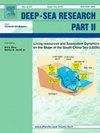Prediction of sardine and anchovy catches by double-boat purse seiners in the northern Persian Gulf using machine learning models
IF 3
3区 地球科学
Q2 OCEANOGRAPHY
Deep-sea Research Part Ii-topical Studies in Oceanography
Pub Date : 2025-06-17
DOI:10.1016/j.dsr2.2025.105502
引用次数: 0
Abstract
Enhancing the efficiency of small pelagic purse-seine fisheries is essential for promoting responsible fisheries management in the Persian Gulf. Therefore, this study forecasts the spatiotemporal catch variations of Sind sardinella (Sardinella sindensis) and Buccaneer anchovy (Encrasicholina punctifer) caught by double-boat purse seiners in the northern Persian Gulf, Qeshm Island. To achieve this, a dataset comprising fishing records from 314 purse seine operations, along with associated environmental parameters obtained from satellite imagery—including sea surface temperature (SST), chlorophyll-a concentration, photosynthetically active radiation (PAR), wind speed, wind direction, depth, and distance—was compiled and analyzed using an advanced machine learning methodology covering the period from September 2014 to October 2023. The evaluation of the regression models used to predict sardine and anchovy catches—including Random Forest (RF), Boosting, and Support Vector Regression (SVR)—revealed varying levels of predictive performance across both species and model types. In the case of sardine, the Boosting Regression model yielded the highest predictive accuracy, characterized by a relatively low error (RMSE = 395.5) and moderate explanatory power (R2 = 0.41). Conversely, for anchovies, the SVR model with a radial basis function (RBF) kernel demonstrated superior performance relative to the other models, with an RMSE of 437 and an R2 of 0.35. The results suggest that anchovy catch prediction was more challenging and potentially influenced by additional unmodeled variables. The CPUE of sardine increases with rising chlorophyll-a concentrations up to approximately 2 mg/m3, but declines beyond this point. The optimal SST range was between 22 °C and 26 °C, whereas sardine catches declined at temperatures exceeding 30 °C. Because anchovy was consistently present across all sampling sets, distance from the shoreline emerged as the most influential parameter contributing to successful net captures. A negative relationship was observed between this factor and anchovy CPUE. As the second most important variable, the optimal SST range for anchovy was similar to that of sardine. Given the substantial fishing effort in the northern Persian Gulf, the findings of this study may help enhance regional fishing strategies by promoting the integration of climate change considerations into operational planning.
使用机器学习模型预测波斯湾北部双船围网捕获的沙丁鱼和凤尾鱼
提高小型远洋围网渔业的效率对于促进波斯湾负责任的渔业管理至关重要。因此,本研究预测了双船围网在波斯湾北部Qeshm岛捕获的沙丁鱼(sardinella sindensis)和Buccaneer anchovy (Encrasicholina punctifer)的时空变化。为了实现这一目标,研究人员编制了一个数据集,其中包括314次围网作业的捕捞记录,以及从卫星图像中获得的相关环境参数,包括海面温度(SST)、叶绿素-a浓度、光合有效辐射(PAR)、风速、风向、深度和距离,并使用先进的机器学习方法对2014年9月至2023年10月期间的数据集进行了分析。对用于预测沙丁鱼和凤尾鱼捕捞量的回归模型(包括随机森林(RF)、Boosting和支持向量回归(SVR))的评估显示,不同物种和模型类型的预测性能水平不同。以沙丁鱼为例,Boosting回归模型的预测精度最高,误差相对较低(RMSE = 395.5),解释能力适中(R2 = 0.41)。相反,对于凤尾鱼,具有径向基函数(RBF)核的SVR模型表现出优于其他模型的性能,RMSE为437,R2为0.35。结果表明,凤尾鱼捕获量预测更具挑战性,并且可能受到其他未建模变量的影响。沙丁鱼的CPUE随着叶绿素a浓度的增加而增加,约为2 mg/m3,但在此之后下降。最佳海温范围为22 ~ 26°C,而超过30°C时,沙丁鱼捕获量下降。由于凤尾鱼在所有采样集中始终存在,因此距离海岸线的距离成为影响成功渔网捕获的最具影响力的参数。该因子与鳀鱼CPUE呈负相关。作为第二重要的变量,凤尾鱼的最佳海温范围与沙丁鱼相似。鉴于波斯湾北部的大量捕鱼活动,这项研究的结果可能有助于通过促进将气候变化考虑纳入业务规划来加强区域捕鱼战略。
本文章由计算机程序翻译,如有差异,请以英文原文为准。
求助全文
约1分钟内获得全文
求助全文
来源期刊
CiteScore
6.40
自引率
16.70%
发文量
115
审稿时长
3 months
期刊介绍:
Deep-Sea Research Part II: Topical Studies in Oceanography publishes topical issues from the many international and interdisciplinary projects which are undertaken in oceanography. Besides these special issues from projects, the journal publishes collections of papers presented at conferences. The special issues regularly have electronic annexes of non-text material (numerical data, images, images, video, etc.) which are published with the special issues in ScienceDirect. Deep-Sea Research Part II was split off as a separate journal devoted to topical issues in 1993. Its companion journal Deep-Sea Research Part I: Oceanographic Research Papers, publishes the regular research papers in this area.

 求助内容:
求助内容: 应助结果提醒方式:
应助结果提醒方式:


